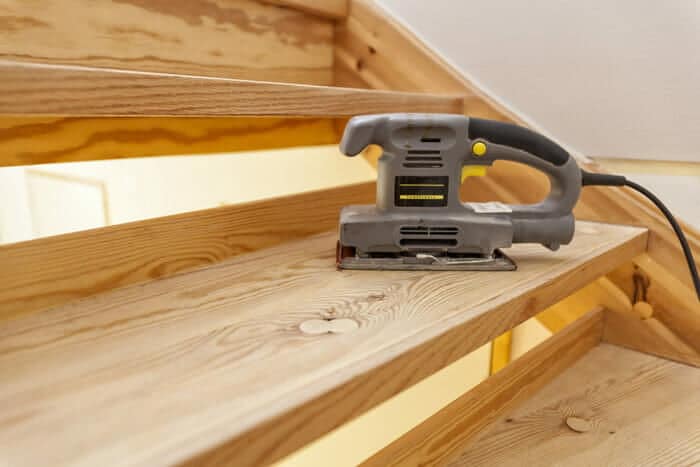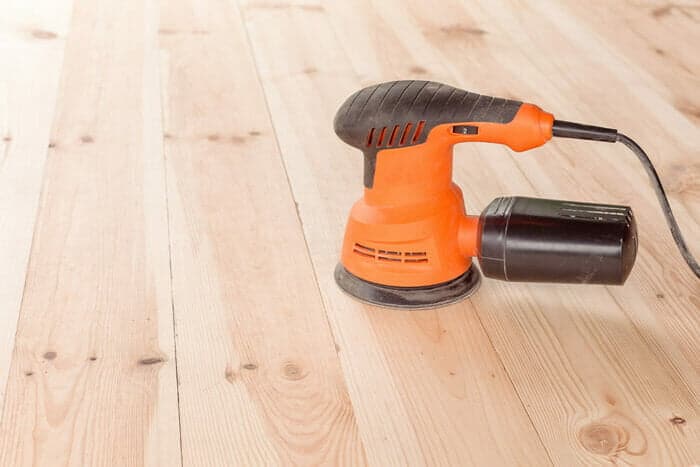The main difference between an orbital sander and a sheet sander is: orbital sanders are good for small, detailed sanding jobs. Sheet sanders, on the other hand, are better for sanding large, flat areas.
If you are working as a carpenter, you know that one of the most common tasks you need to do is sanding.
If you have experience in woodworking tasks, then you probably know that using a sander can be quite an enjoyable experience. However, this is true only when you use the correct type of sander for your job.
Two of the most commonly used types of sander are the random orbital sander and the sheet sander.
In this article, we will discuss which of these sanders is suited for what kind of job, their differences, and their pros and cons.
The Sheet Sander
The sheet sander is also known as the finish sander, and just like that name suggests, it is intended to be used for the finishing touches on the piece you are working on.
Additionally, the sheet sander is called a palm sander or a quarter sheet pad sander. This name is derived from the sandpaper used with this tool, which is a quarter of the 9×11 sheet.

Palm Sanders – BestSeller
- POWERFUL – With a 2.8 amp motor and 13,000…
- EASY TO CLEAN DUST CONTAINER – The X-flow…
- POWERFUL – With a 1. 2 amp motor and 13,500…
- VERSATILITY ON THE QUICK – This 4-in-1 detail…
- 2.3 AMP motor of the electric sander sands at…
- Rubber overmold texture of the 1/4 sheet…
- Features a 3.75 x 5.5 inch pad with an angled…
- Powerful one-amp motor provides 13,500 OPM
- VERSATILE USE – Use this handheld sander on…
- PADDLE SWITCH ACTUATION – Soft-grip paddle…
- 3.0-amp motor of the orbital sander spins the…
- Shorter height of the hand sander allows the…
- Orbital sander with brushless motor provides…
- Variable-speed control of the hand sander…
- 3.0-amp motor of the orbital sander spins the…
- Separate counterweight design of the hand…
- Orbital sander with brushless motor provides…
- Variable-speed control of the hand sander…
- COMPACT DESIGN – Allows access to cramped…
- POWERFUL MOTOR – 1.2 Amp motor supplies…
Usually, sheet sanders have a rectangular sanding pad. This type of sander works in a basic, back, and forth circular movement at high speeds. This makes the tool ideal for detailed work and small surfaces. The sanding pad’s rectangle shapes, especially square ones, make the sheet sander an excellent choice for edges and corners.
Since the sheet sander works in a back-and-forth movement, it is not suitable for removing lots of material in one go. This tool is not designed to cut through layers in short amounts of time. Even if you try, you probably won’t make much progress and will waste time and energy.
One of the best things about owning and using a sheet sander is its initial cost and its recurring costs of usage. This tool is less expensive than most of the other sanders and, at the same time, utilizes regular sandpaper, which is cheap.
So let’s go on and see one by one the pros and cons of the sheet sander.
Sheet Sander Pros
- Availability. This sheet sander is relatively available, and the sandpaper it utilizes can be found almost everywhere.
- Inexpensive. This tool is budget-friendly, and with a bit of practice, you should be able to access a broad spectrum of jobs.
- Ideal for corners, edges, and curves. Not every sander can reach tight spots or is designed to do corners; this is one of the strengths of the sheet sander.
- Lightweight. This tool will not tire you quickly, which is important if you are a professional carpenter working for hours on his projects.
- Portability. As we mentioned above, being lightweight makes for a tool that can be grabbed on the go.
- Ideal for doing finishing touches and details while also being an excellent choice for sanding and smoothing between coating and paint layers.
Sheet Sander Cons
- Low power output. This tool is not meant for heavy-duty tasks; it is intended for details and finishing touches. You won’t accomplish much if you try using it on large surfaces or removing lots of material.
- Low versatility. Again, the sheet sander is used mainly for finishing touches and some spots which are not quickly done with other types of sanders, like corners.
- A tendency to leave marks. Because of its steady motion, the sanding pad can sometimes leave swirl marks on your piece if you are not careful.
Orbital Sander
The orbital sander has a lot in common with the sheet sander. These two tools look almost the same, but they have some fundamental differences.
First of all, this tool is also known as a random orbital sander, and this has to do with the way this tool is functioning, which is the main difference between this tool and the sheet sander.
This difference is the way the sanding pad is moving.

Orbital Sander – BestSeller
- POWERFUL – With a 2.8 amp motor and 13,000…
- EASY TO CLEAN DUST CONTAINER – The X-flow…
- 3.0-amp motor of the orbital sander spins the…
- Separate counterweight design of the hand…
- Orbital sander with brushless motor provides…
- Variable-speed control of the hand sander…
- 3.0-amp motor of the orbital sander spins the…
- Shorter height of the hand sander allows the…
- HIGH PERFORMANCE ORBIT SANDER – 2.0 Amp…
- HIGH EFFICIENCY – Delivers 12000 OPM (orbits…
- Orbital sander with brushless motor provides…
- Variable-speed control of the hand sander…
- Integral pad dampening braking system to…
- 2.5 Amp motor delivers 12,000 OPM
- 【Powerful Operating System & 6 Various…
- 【16 Pcs Sandpapers & Magic Tape】Our hand…
- Milwaukee Electric Tools 2648-20 M18 Random…
- This product meets customer requirement
- BUILT FOR HIGH OUTPUT: Delivers up to 12,000…
- DETACHABLE DUST BAG HELPS SAVE TIME: Easily…
The orbital sander’s motor moves the sanding pad in a randomized circular motion. This is achieved with an additional drive, which makes the sanding pad do an elliptical movement.
This randomized movement is achieved to minimize the swirl marks left on the surface by the sheet sander.
However, the additional requirements needed to build an orbital sander instead of a sheet sander make this tool more powerful and more expensive.
This extra power can be utilized, allowing us to use the orbital sander on rougher types of material and through a couple of layers, something the sheet sander cannot do.
The circular disk on the sanding pad has holes that are used as a part of the tool’s dust collection mechanism. At the end of the arrangement, the dust is usually collected in a dust bag. Alternatively, suppose you are a professional carpenter. In that case, you can connect the tool to your shop’s vacuum hose to ensure that all of the dust is collected and your workplace is clean.
Another thing you should take into account about random orbital sanders is that they produce a lot of vibration. If you use this tool for large amounts of time, there is a chance you will suffer from numbness or hand fatigue.
Fear not, though, this is a minor issue, and there are many ways you go around this. First of all, a lot of models include an anti-vibration mechanism, which reduces the number of vibrations reaching you by a lot. Additionally, you can use an anti-vibration glove. Lastly, it would be best if you always take frequent breaks to be on the safe side.
Orbital Sander Pros
- Stronger motor. Since the orbital sander needs to randomize the motion of its sanding pad and thus is more powerful than the sheet sander. This extra power makes the tool really good at removing material.
- Versatility. The orbital sander has a wide range of use. The randomized circular motion, along with its high power output, allows the user to utilize the spot in a lot of different situations and materials.
- Dust collection mechanism. This feature is especially important for professionals who do a lot of sanding work every day and need a way to keep their workplace clean.
- Do not leave swirl marks. This was explained above; the random swirling pattern prevents the tool from leaving marks on your woodworking piece.
- Smooth finishing. Although this tool holds more power than the sheet sander, the fact that it will not leave marks makes the device appropriate for finishing touches.
- Variable speed control. Some models of orbital sander bring the extra feature of variable speed control. This comes in the form of a trigger with a certain number of speed settings. The user can alternate between those setting depending on the type of material he is working on.
- Decreased fatigue. This is another optional feature on some orbital sander models, including a vibration absorption mechanism. The tool is handled efficiently by reducing the vibrations, and the user can do the sanding more relaxedly without much effort.
Orbital Sander Cons
- It cannot reach corners. The round sanding disc, along with the circular movement, makes this tool unable to reach corners and ninety-degree angles.
- Costly tool and maintenance. The extra power and features of this tool are there in the price. Also, since this tool uses circle sandpapers, there is an increase in cost as well because of that. This is why some DIY enthusiasts reuse their used orbital sandpaper.
- Not suited for smoothing between layers.
- Aggressiveness. Since this tool is more aggressive than the sheet sander, the user must be a little more careful with certain types of material in order to avoid damage.
Conclusion
By now, you should have a clear picture of both the sheet sander and the random orbital sander and the way they function, along with their basic features, pros, and cons.
We already mentioned that these two types of sanders are quite similar to each other but are not intended for precisely the same job, so there is no right choice.
Suppose you are an amateur or an enthusiast who does projects for fun. In that case, we suggest you get a random orbital sander. Although this power tool is more expensive than the sheet sander, it is more versatile, and you should be able to experiment more with it and improve your skills.
Ideally, we would suggest you get both of those tools, but not everyone can afford them.
Suppose you want to be considered a professional, though. In that case, you should definitely own both of these since there are occasions you will need both of those if you’re going to do your job as well as possible.
Remember that there is no magic tool that can do everything, so If you want to be the best carpenter around, you need a fully equipped workshop ready to do any business.
Finally, we should note that people with experience should use these tools. Ideally, there should be some supervision or training for people who have just started to learn to use power tools.















